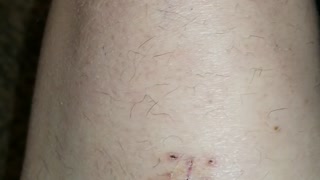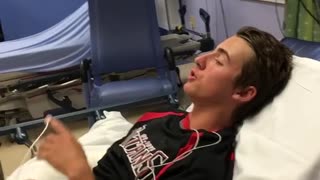Premium Only Content

Knee Surgery for a Meniscus Tear
Meet Doretha.
Doretha came to Synapse Orthopedic Group after being injured in a bus accident. Edwin Haronian MD performed knee surgery to repair her torn meniscus., she is now recovering from her injury. She is now in the process of doing further therapy to strengthen her knee. Let's wish her a great recovery.
Call us to schedule an appointment: (818) 788-2400
Locations in Pomona, Sherman Oaks, and Los Angeles
A meniscus tear is a common injury to the cartilage that stabilizes and cushions the knee joint. The type of the tear can determine whether your tear can be repaired. Radial tears sometimes can be repaired, depending on where they are located. Horizontal, flap, long-standing, and degenerative tears-those caused by years of wear and tear-generally cannot be repaired.
Your doctor will likely suggest the treatment that he or she thinks will work best for you based on the zone where the tear is , the pattern of the tear, and how big it is. Your age, your health, and your activity level may also affect your treatment options. In some cases, the surgeon makes the final decision during surgery, when he or she can see the how strong the meniscus is, where the tear is, and how big the tear is.
If you have a small tear at the outer edge of the meniscus (in what doctors call the red zone), you may want to try home treatment. These tears often heal with rest.
If you have a moderate to large tear at the outer edge of the meniscus (red zone), you may want to think about surgery. These kinds of tears tend to heal well after surgery.
If you have a tear that spreads from the red zone into the inner two-thirds of the meniscus (called the white zone), your decision is harder. Surgery to repair these kinds of tears may not work.
If you have a tear in the white zone of the meniscus, repair surgery usually isn't done, because the meniscus may not heal. But partial meniscectomy may be done if torn pieces of meniscus are causing pain and swelling.
Surgical repair may be done by open surgery, in which a small incision is made and the knee is opened up so that the surgeon can see inside the knee and the meniscus can be repaired. Increasingly, surgeons use arthroscopic surgery to repair the meniscus. The surgeon inserts a thin tube (arthroscope) containing a camera and a light through small incisions near the knee and is able to see inside the knee without making a large incision. Surgical instruments can be inserted through other small incisions. The surgeon repairs the meniscus using sutures (stitches) or anchors.
Other knee injuries-most commonly to the anterior cruciate ligament (ACL)-may occur at the same time as a torn meniscus. In these cases, the treatment plan is altered. Typically, your orthopedist will repair your torn meniscus, if needed, at the same time ACL surgery is done. In this case, the ACL rehabilitation plan is followed. To learn more, see the topic Anterior Cruciate Ligament (ACL) Injuries.
What To Expect After Surgery
Your surgeon may recommend that you do not move your knee more than absolutely necessary (immobilization) for 2 weeks after surgery. This may be followed by 2 weeks of limited motion before you are able to resume daily activities. Physical therapy should begin right after surgery. But heavy stresses, such as running and squats, should be postponed for some months. You must follow your doctor's rehabilitation (rehab) plan for optimum healing. Afterwards, you may still continue to have pain and require more physical therapy or, sometimes, additional surgery.
The timetable for returning to walking, driving, and more vigorous activities will depend on your success in rehab.
Why It Is Done
How your doctor treats a meniscus tear depends upon the size and location of the tear, your age, your health and activity level, and when the injury occurred. Treatment options include nonsurgical treatment with rest, ice, compression, elevation, and physical therapy; surgical repair; surgical removal of the torn section (partial meniscectomy); and surgical removal of the entire meniscus (total meniscectomy). In general, surgical repair is favored over partial or total meniscectomy. If the meniscus can be repaired successfully, saving the injured meniscus by doing a meniscal repair-rather than partial or total removal-reduces the occurrence of knee-joint degeneration.
Small tears located at the outer edge of the meniscus often heal on their own. Larger tears located toward the center of the meniscus may not heal well, because blood supply to that area is poor. In a young person, surgery to repair the tear may be the first choice, because it may restore function.
For more information please visit our website at: http://www.synapsedoctor.com
You can also follow our social media pages at:
http://www.facebook.com/synapsedoctor
http://www.instagram.com/synapsedoctor
http://www.twitter.com/synapsedoctor
-
 1:39
1:39
buchholzbob
4 years ago $0.03 earnedKnee Surgery
972 -
 3:26
3:26
Daughteroftheking80
4 years agoTummy-tuck Surgery Interview
129 -
 0:17
0:17
bootman29
4 years ago $0.09 earnedNew teeth post surgery
177 -
 3:01
3:01
WKBW
4 years agoRECONSTRUCTIVE BREAST SURGERY
364 -
 2:32
2:32
Daughteroftheking80
4 years ago $0.01 earnedTummy Tuck Surgery Morning
46 -
 0:21
0:21
ozarkmomma2
4 years agoPlaying after surgery
308 -
 6:14
6:14
ViralHog
6 years ago $0.11 earnedPost Surgery Rant
436 -
 1:00
1:00
Catmando-TNR
4 years agoPost surgery returns
38 -
 3:28
3:28
KTNV
4 years agoRecovery After Cosmetic Surgery
121 -
 45:57
45:57
LadySnake
4 years agoNanotechnology for Spinal Surgery
46